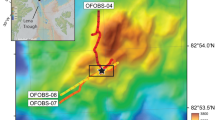Abstract
The ∼ 2220 Ma Kalahari Manganese field of South Africa is the world's largest Mn resource and a major producer. Current models for its origin rely on those developed for Phanerozoic deposits, invoking a submarine redox boundary and water movements across a continental shelf, precipitating Mn oxides from the sea. Here we report the discovery of major hydrothermal alteration in the thick andesitic volcanic pile beneath the Mn ore. This and other evidence shows that the Kalahari manganese is actually a volcanic exhalative deposit, analogous in some respects to those forming at present day mid-ocean ridges. Important differences in depth and oxygen supply account for the smaller area and high grade of the Kalahari Manganese Field, compared with the widespread but thinly developed modern ocean floor Mn deposits.
Similar content being viewed by others
References
Alt, J.C. Honnorez, J. (1984) Alteration of the upper oceanic crust, DSDP site 417; mineralogy and chemistry. Contrib. Mineral. Petrol. 87:149–169
Beukes, N.J. (1983) Palaeoenvironmental setting of iron formations in the depositional basin of the Transvaal Supergroup, South Africa. In: Trendall, A.F. Morris, A.C. (eds.) Iron formation, facts and problems. Elsevier, Amsterdam, pp. 131–209
Beukes, N.J. Smit, C.A. (1987) New evidence for thrust faulting in Griqualand West, South Africa: implications for stratigraphy and red beds. S. Afr. J. Geol. 90:378–394
Cannon, W.F. Force, E.R. (1983) Potential for high-grade shallow-marine manganese deposits in North America. In: Shanks, W. (ed.) Unconventional mineral deposits. Am. Inst. Mining Metall. Petroleum Eng, New York, pp. 175–190
Cornell, D.H., Schütte, S.S., Eglington, B.L. (1995) The Ongeluk Basaltic Andesite Formation in Griqualand West, South Africa: submarine alteration in a 2220 Ma Proterozoic sea. Precambrian Res. (in press)
De Villiers, J.E. (1983) The manganese deposits of Griqualand West, South Africa: some mineralogical aspects. Econ. Geol. 78:1108–1118
Dixon, R.D. (1989) Sugilite and associated metamorphic silicate minerals from Wessels Mine, Kalahari Manganese Field. Geol. Surv. Bull. S. Afr. 93: 47 pp
Evensen, N.M., Hamilton, P.J., O'Nions, R.K. (1978) Rare-earth abundances in chondritic meteorites. Geochim. Cosmochim. Acta 42:1199–1212
Fleet, A.J. (1983) Hydrothermal and hydrogenous Ferro-manganese deposits: do they form a continuum? The rare earth evidence. In: Rona, P.A., Boström, K., Laubier, L., Smith, K.L. (eds.) Hydrothermal processes at seafloor spreading centers. Nato Conf. Ss. IV, vol. 12, Plenum Press, New York, pp. 535–556
Force, E.R., Cannon, W.F. (1984) Depositional model for shallow-marine manganese deposits around black shale basins. Econ. Geol. 83:93–117
Frakes, L.A., Bolton, B.R. (1984) Origin of manganese giants: sea level change and anoxic-oxic history. Geology 12:83–86
Frakes, L.A., Bolton, B.R. (1992) Effects of ocean chemistry, sea level and climate on the formation of primary sedimentary manganese ore deposits. Econ. Geol. 87:1207–1217
Grobbelaar, W.S., Beukes, N.J. (1986) The Bishop and Glossam manganese mines and the Beeshoek iron ore mine of the Postmasburg area. In: Annhaeusser, C.R., Maske, S. (eds.) Mineral Deposits of South Africa, vol. 1. Geol. Soc. S. Afr., pp. 957–961
Hynes, A. (1980) Carbonatization and mobility of Ti, Y, and Zr in Ascot Formation metabasalts, S.E. Quebec. Contrib. Mineral. Petrol. 75:79–87
Kleyenstüber, A.S.E. (1984) The mineralogy of the manganese-bearing Hotazel formation, of the Proterozoic Transvaal Sequence in Griqualand West, South Africa. Trans. Geol. Soc. S. Afr. 87:257–272
Lalou, C. (1983) Genesis of ferromanganese deposits: hydrothermal origin. In: Rona, P.A., Boström, K., Laubier, L., Smith, K.L. (eds.) Hydrothermal processes at seafloor spreading centers. Nato Conf. Ss. IV, vol. 12, Plenum Press, New York, pp. 503–534
Roy, S. (1992) Environments and processes of manganese deposition. Econ. Geol. 87:1218–1236
Schissel, D., Aro, P. (1992) The major early Proterozoic sedimentary iron and manganese deposits and their tectonic setting. Econ. Geol. 87:1367–1374
Schütte, S.S. (1992) Ongeluk volcanism in relation to the Kalahari Manganese Deposits. Unpublished PhD thesis, Univ. Natal, S. Afr, 255 pp
Stowe, C.W., Hartnady, C.J.H., Joubert, P. (1984) Proterozoic tectonic provinces of southern Africa. Precambrian Res. 25:229–231
Taylor, S.R., McLennan, S.M. (1985) The continental crust: its composition and evolution. Blackwell, Oxford, 321pp
Author information
Authors and Affiliations
Rights and permissions
About this article
Cite this article
Cornell, D.H., Schütte, S.S. A volcanic-exhalative origin for the world's largest (Kalahari) Manganese field. Mineral. Deposita 30, 146–151 (1995). https://doi.org/10.1007/BF00189343
Received:
Accepted:
Issue Date:
DOI: https://doi.org/10.1007/BF00189343




